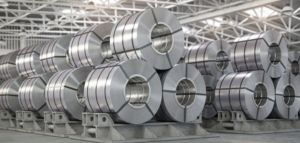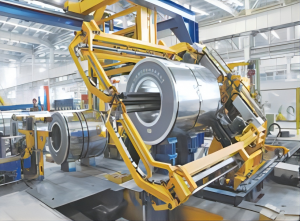Optimizing Steel Coil Packaging: Understanding the Automatic Steel Strap Coil Wrapping Machine
Protecting steel coils during storage and transport is crucial to prevent damage, corrosion, and ensure product quality upon arrival. An effective solution in modern manufacturing and logistics is the automatic steel strap coil wrapping machine, particularly models equipped with dual wrapping stations for enhanced throughput. This guide explores the functionality, benefits, and key features of these automated systems.
1. How Does an Automatic Steel Strap Coil Wrapping Machine Work?
These machines automate the process of applying protective wrapping material (like stretch film) around a steel coil and then securing it with steel strapping. The process typically involves several automated stages:

- Coil Loading: Coils are loaded onto the machine's conveyor or rotating platform, often horizontally (eye to the sky or eye to the wall, depending on machine design).
- Protective Wrapping: The wrapping station dispenses protective film (e.g., stretch film, VCI film, paper) and rotates the coil or the wrapping head around the coil to apply the material securely around the outer diameter and potentially the faces.
- Steel Strapping: Once wrapping is complete, the coil moves to a strapping station (or the strapping unit engages). Steel straps are automatically fed around the coil circumference at predetermined positions, tensioned, sealed (usually via notch or seal-less joint), and cut.
- Coil Unloading: The fully wrapped and strapped coil is moved off the machine, ready for storage or shipment.
Machines with two wrapping/strapping stations can process two coils simultaneously or sequentially in different stages, significantly boosting packaging speed.
2. Key Benefits of Automated Coil Wrapping and Strapping
Implementing an automated system offers substantial advantages:
- Enhanced Efficiency: Dual stations dramatically increase throughput compared to single-station or manual methods. Automation ensures consistent cycle times.
- Superior Product Protection: Uniform application of wrapping film shields coils from moisture, dust, and surface damage. Steel strapping provides robust stabilization, preventing coil telescoping or unwinding during handling.
- Improved Operational Safety: Automating the heavy tasks of wrapping and strapping reduces manual handling risks for operators. Machines incorporate safety features like guards and sensors.
- Reduced Material Waste: Precise control over film stretch and strap tension minimizes material consumption compared to manual application.
- Consistent Packaging Quality: Automation ensures every coil is packaged to the same standard, improving load security and customer satisfaction.
3. Core Features and Functionality
Modern automatic steel strap coil wrapping machines often include:
3.1. Dual Wrapping/Strapping Stations
This core feature allows for higher processing speeds by handling multiple coils concurrently or in a streamlined sequence.
3.2. Automated Wrapping Dispenser
- Handles various wrapping materials: Stretch film, VCI (Volatile Corrosion Inhibitor) film, paper, or combinations.
- Features powered pre-stretch capabilities to maximize film yield and load containment.
- Automatic film clamping, cutting, and wiping/sealing mechanisms.

steel coil strapping machine 3.3. Automated Steel Strapping Unit
- Integrates strapping heads designed for heavy-duty steel straps.
- Automatic strap feeding, tensioning, sealing (notch, seal, or seal-less joints), and cutting.
- Can often place multiple straps at precise locations around the coil circumference.
3.4. Adjustable Wrapping & Strapping Parameters
- Allows customization via the control panel (HMI) for different coil sizes (diameter, width, weight).
- Settings include number of film wraps, overlap percentage, strap tension levels, and strap positions.
3.5. Control System (PLC/HMI)
- Programmable Logic Controller (PLC) for reliable process automation.
- Human-Machine Interface (HMI) touchscreen for easy operation, parameter adjustment, recipe storage, and diagnostics.
3.6. Robust Construction
- Built with heavy-duty steel frames and high-quality components to withstand demanding industrial environments and heavy coil loads.
3.7. Safety Features
- Includes safety fencing, light curtains, emergency stops, and interlocked access doors to protect personnel during operation.
4. Applications in Industry
These machines are essential in environments handling large volumes of steel coils, including:
- Steel Mills
- Metal Service Centers
- Tube and Pipe Manufacturers
- Automotive Stamping Plants
- Wire and Cable Production
5. Considerations When Selecting a Machine
Choosing the right system depends on specific needs:
- Coil Specifications: Maximum/minimum diameter, width, and weight of the coils to be processed.
- Throughput Requirements: The number of coils that need to be packaged per hour or shift.
- Wrapping & Strapping Needs: Types of protective film required, number and type of straps needed per coil.
- Automation Level: Integration requirements with existing production lines, conveyors, cranes, or AGVs.
- Footprint and Layout: Available space in the facility.
- Budget: Initial investment cost versus long-term operational savings.
6. Conclusion

Automatic steel strap coil wrapping machines, especially dual-station models, represent a significant advancement in steel coil packaging technology. They provide a reliable, efficient, and safe method for protecting valuable steel products, ensuring they reach their destination in optimal condition while streamlining plant operations. By understanding their capabilities and features, businesses can make informed decisions to enhance their packaging processes.
